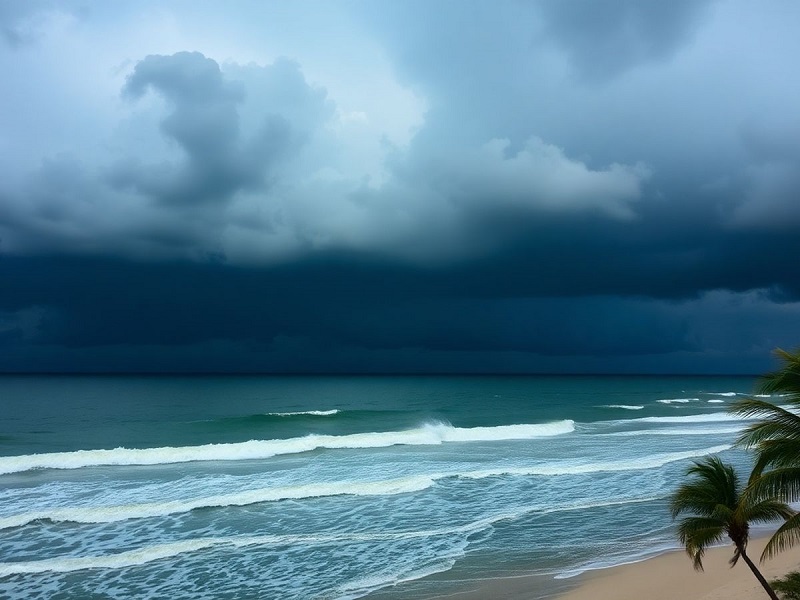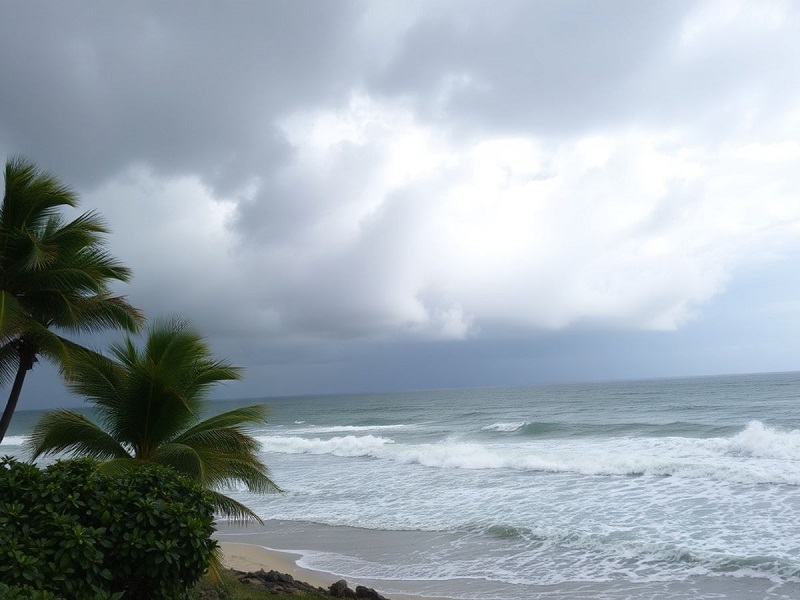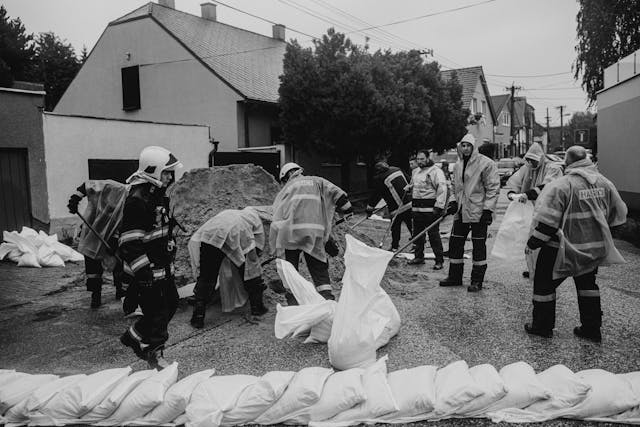Hurricane Helene is making its way towards the Gulf Coast, and it’s important for residents to be prepared. This storm has the potential to bring strong winds, heavy rain, and dangerous storm surges. Understanding what to expect can help communities stay safe and minimize damage as the hurricane approaches.
Key Takeaways
- Hurricane Helene is expected to make landfall along the Gulf Coast, impacting areas from New Orleans to Key West.
- Residents should prepare emergency kits and have evacuation plans ready before the storm hits.
- Strong winds and heavy rainfall can lead to flooding, especially in low-lying areas.
- Power outages are likely, so it’s crucial to have backup power sources and supplies.
- Community support and resources will be available for recovery after the storm passes.
Hurricane Helene’s Path and Potential Landfall
Current Forecast Models
Hurricane Helene is on the move, and the latest forecast models show it tracking north into the Gulf of Mexico. Experts predict it could make landfall between Mobile and Tampa, likely hitting Florida’s Panhandle or Big Bend region. Residents in these areas should stay alert and prepare for possible impacts.
Regions Most at Risk
The areas most at risk from Hurricane Helene include:
- Florida Panhandle
- Big Bend region
- Coastal Alabama
- Southern Mississippi
These regions are particularly vulnerable due to their geography and previous storm impacts.
Historical Comparisons
When comparing Helene to past hurricanes, it’s important to note that similar setups have led to significant storms in the past. For instance, hurricanes like Idalia and others have shown how quickly conditions can change.
The Gulf Coast has seen its share of storms, and each one teaches us something new about preparation and resilience.
In summary, as Hurricane Helene approaches, residents should keep an eye on updates and be ready for anything. Preparation is key to staying safe during this storm.
Preparing for Hurricane Helene

Essential Supplies to Stock Up On
When a hurricane is on the way, it’s crucial to have the right supplies ready. Here’s a quick list of essentials:
- Water: At least one gallon per person per day for three days.
- Non-perishable food: Enough for at least three days.
- First aid kit: Include any necessary medications.
Don’t forget to have a flashlight and extra batteries!
Evacuation Plans and Routes
Planning ahead can save lives. Here are some steps to consider:
- Know your evacuation routes: Check local maps and stay updated.
- Have a meeting place: Choose a safe spot for your family to gather.
- Stay informed: Keep an eye on local news for updates on Hurricane Helene.
Securing Your Home
Before the storm hits, make sure your home is ready:
- Board up windows: Use plywood or storm shutters.
- Secure outdoor items: Bring in furniture, decorations, and anything that could become a projectile.
- Check your insurance: Ensure your policy covers hurricane damage.
Preparing for a hurricane isn’t just about supplies; it’s about keeping your family safe and informed.
In summary, being proactive is key. As Hurricane Helene approaches, residents should take these steps seriously to ensure their safety and well-being. Stay safe and be prepared!
Expected Weather Conditions
Wind Speeds and Gusts
As Hurricane Helene approaches, wind speeds are expected to increase significantly. Residents should prepare for strong gusts that could reach up to 70 mph in some areas. Here’s a quick look at the forecasted wind speeds:
| Region | Wind Speed (mph) | Gusts (mph) |
|---|---|---|
| Coastal Louisiana | 60-70 | 80-90 |
| Southern Mississippi | 50-60 | 70-80 |
| Alabama Coast | 40-50 | 60-70 |
Heavy Rainfall and Flooding
Rainfall is another major concern. Helene could bring heavy rain, leading to potential flooding. Here’s what to expect:
- Up to 10 inches of rain in some areas.
- Flash flooding is likely, especially in low-lying regions.
- Residents should stay alert for updates on local conditions.
Storm Surge and Coastal Impact
The storm surge could be severe, especially along the Gulf Coast. Here are some key points:
- Surge heights could reach 5-8 feet in vulnerable areas.
- Coastal communities should prepare for possible evacuations.
- It’s crucial to monitor local advisories for real-time updates.
As the storm approaches, it’s essential for everyone to stay informed and take necessary precautions.
In summary, as Florida to Louisiana braces for Hurricane Helene, residents should be ready for strong winds, heavy rain, and dangerous storm surges. Keeping an eye on the weather updates is vital to ensure safety during this time.
Impact on Local Communities
Potential Power Outages
As Hurricane Helene approaches, communities are bracing for potential power outages. High winds and heavy rain can easily knock down power lines, leaving many without electricity. Residents should prepare by:
- Charging devices in advance
- Stocking up on flashlights and batteries
- Having a backup power source if possible
School and Business Closures
In anticipation of the storm, many schools and businesses may close their doors. This can disrupt daily life and affect local economies. It’s important for families to stay updated on closures through local news and social media.
Emergency Services and Shelters
Emergency services will be on high alert as the storm approaches. Local shelters will open to provide safe havens for those in need. Residents should know:
- The locations of nearby shelters
- What to bring (like food, water, and personal items)
- How to stay informed about shelter availability
Communities often come together during tough times. It’s crucial to check on neighbors and offer help where possible.
In summary, the impact of Hurricane Helene on local communities can be significant, affecting power, schools, and emergency services. Being prepared can make a big difference in how residents cope with the storm’s aftermath. Stay safe!
Safety Tips During the Hurricane

Staying Informed with Alerts
Keeping up with the latest updates is crucial. Make sure to have your cell phone fully charged and download weather apps to receive alerts. This way, you can stay informed about any changes in the storm’s path or intensity.
Safe Places to Take Shelter
When the storm hits, finding a safe spot is essential. Here are some tips:
- Stay away from windows to avoid flying debris.
- Choose a sturdy interior room on the lowest level of your home.
- If you’re in a mobile home, consider going to a nearby shelter.
Handling Power Outages
Power outages are common during hurricanes. Here’s how to prepare:
- Stock up on flashlights and batteries.
- Keep a supply of non-perishable food and water.
- Have a backup power source, like a generator, if possible.
Remember, preparation is key! Having a plan can make all the difference when the storm arrives.
In summary, staying safe during Hurricane Helene involves being informed, finding secure shelter, and preparing for power outages. Stay safe and be ready!
After the Storm: Recovery and Cleanup
Assessing Damage to Property
Once the storm has passed, the first step for many is to check their homes and properties for damage. It’s crucial to document everything with photos for insurance claims. Here are some common areas to inspect:
- Roofs for missing shingles or leaks
- Windows and doors for cracks or breaks
- Basements for flooding or water damage
Dealing with Insurance Claims
Filing insurance claims can be a daunting task, but it’s essential for recovery. Here’s a simple guide to help:
- Gather all necessary documents, including photos and receipts.
- Contact your insurance company as soon as possible.
- Keep a record of all communications with your insurer.
Community Support and Resources
In the aftermath of a hurricane, community support is vital. Local organizations often step in to help residents recover. Here are some resources to look for:
- Food banks and shelters
- Volunteer groups for cleanup efforts
- Local government assistance programs
Many Gulf Coast residents are still reeling from Hurricane Ida, but over the years, the area has become more resilient against storms, improving drainage and pumping stations and replacing roofs that can better withstand the elements.
As communities come together, the spirit of resilience shines through, reminding everyone that recovery is a shared journey.
Comparing Helene to Past Hurricanes

Lessons Learned from Previous Storms
When looking at Hurricane Helene, it’s essential to reflect on past hurricanes to understand what might happen. Here are some key lessons:
- Preparation is crucial: Many communities learned the hard way that being ready can save lives.
- Evacuation routes matter: Knowing the best paths to safety can make a big difference.
- Stay informed: Keeping up with updates can help residents make better decisions.
Changes in Hurricane Preparedness
Over the years, hurricane preparedness has evolved significantly. Here are some notable changes:
- Improved forecasting technology: Modern tools provide more accurate predictions.
- Community drills: Many areas now conduct regular drills to ensure everyone knows what to do.
- Better communication: Alerts and updates are more accessible than ever, helping people stay informed.
Notable Differences in Impact
Hurricane Helene’s potential impact can be compared to past storms. Here’s a quick look:
| Hurricane Name | Year | Category | Max Wind Speed (mph) |
|---|---|---|---|
| Helene | 1958 | 4 | 150 |
| Katrina | 2005 | 5 | 175 |
| Harvey | 2017 | 4 | 130 |
Hurricane Helene was recorded as a category 4 storm, making it one of the more severe events in history. Understanding these comparisons helps communities prepare better for what’s to come.
The past teaches us that preparation and awareness can significantly reduce the impact of hurricanes on communities.
Environmental Factors Influencing Helene
Warm Gulf Waters
The Gulf of Mexico is known for its warm waters, which can fuel hurricanes. Higher temperatures can lead to stronger storms. This is especially true for Hurricane Helene, as it moves over these warm waters, potentially increasing its intensity.
Central America Gyre
The Central America Gyre plays a significant role in storm development. This large-scale rotation can create low-pressure areas that help storms form. As Helene approaches, this gyre could influence its path and strength.
Climate Change Effects
Climate change is a hot topic when discussing hurricanes. Studies suggest that it may be causing an increase in the severity of storms. This means that hurricanes like Helene could be more intense than those in the past.
Understanding the impact of climate change is crucial for communities to prepare for future storms.
Summary of Influencing Factors
| Factor | Description |
|---|---|
| Warm Gulf Waters | Fuels storm intensity |
| Central America Gyre | Influences storm path and development |
| Climate Change Effects | Potentially increases storm severity |
Key Takeaways
- Warm waters can intensify hurricanes.
- The Central America Gyre can help storms develop.
- Climate change may lead to more severe hurricanes.
By keeping an eye on these environmental factors, residents can better prepare for Hurricane Helene’s impact.
Tracking the Storm: Tools and Technology
Using Weather Apps
In today’s world, staying updated on hurricanes is easier than ever. Weather apps provide real-time alerts and forecasts right on your phone. Here are some popular options:
- The Weather Channel App
- AccuWeather
- NOAA Weather Radar
Satellite and Radar Imagery
Satellite images and radar data are crucial for tracking hurricanes. They show the storm’s size, movement, and intensity. This information helps meteorologists predict where the storm might go next. For example, the latest satellite images can reveal:
- Cloud patterns
- Wind speeds
- Rainfall estimates
Expert Meteorologist Insights
Meteorologists play a key role in understanding hurricanes. They analyze data from various sources to provide accurate forecasts. Their insights can help communities prepare better. Here are some ways they contribute:
- Interpreting complex data
- Offering safety tips
- Updating the public on changes in the storm’s path
Staying informed is essential during hurricane season. The more you know, the better prepared you’ll be!
By using these tools and resources, residents can stay ahead of Hurricane Helene and ensure their safety as it approaches the Gulf Coast.
Economic Impact of Hurricane Helene
Cost of Damages
Hurricane Helene is expected to cause significant damage as it approaches the Gulf Coast. The financial toll could reach billions of dollars. Here’s a quick breakdown of potential costs:
| Damage Type | Estimated Cost (in billions) |
|---|---|
| Infrastructure | 2.5 |
| Residential Property | 3.0 |
| Business Losses | 1.5 |
| Total | 7.0 |
Effect on Local Businesses
Local businesses are bracing for impact. Many are preparing for possible closures, which can lead to:
- Loss of revenue during the storm
- Increased costs for repairs
- Potential layoffs if the situation worsens
Long-term Economic Recovery
The recovery process can take time. Communities may face challenges such as:
- Rebuilding infrastructure
- Restoring services like electricity and water
- Supporting local businesses to get back on their feet
The aftermath of a hurricane can be tough, but communities often come together to rebuild and support one another.
In summary, the economic impact of Hurricane Helene could be severe, affecting everything from homes to businesses. Residents should prepare for both immediate and long-term challenges as the storm approaches.
Community Stories and Experiences

Personal Accounts of Preparation
As Hurricane Helene approaches, many residents are sharing their stories of how they are getting ready. One family in Louisiana has stocked up on essentials like water, canned goods, and batteries. They emphasize the importance of being prepared, especially after experiencing past storms.
Volunteer Efforts and Support
Local organizations are stepping up to help those in need. Volunteers are gathering supplies and offering assistance to families who may not have the means to prepare. Here are some ways the community is coming together:
- Food drives to collect non-perishable items.
- Shelter setups for those who need a safe place to stay.
- Transportation services for those who need help evacuating.
Resilience and Rebuilding
After the storm, communities often face the tough task of rebuilding. Many residents reflect on how previous hurricanes have taught them valuable lessons about resilience. Learning from past experiences helps them face new challenges with a stronger spirit.
“Every storm brings us closer together, and we always find a way to bounce back.”
In summary, the stories of preparation, support, and resilience highlight the strength of communities facing Hurricane Helene. Together, they are ready to face whatever comes their way.
Wrapping It Up: Stay Safe and Prepared!
As Hurricane Helene gets closer to the Gulf Coast, it’s super important to stay alert and ready. Make sure you have your emergency kit packed and know your evacuation routes. The storm could bring strong winds and heavy rain, so don’t take any chances. Keep an eye on updates from local news and weather services. Remember, it’s better to be safe than sorry! Stay safe, everyone!




